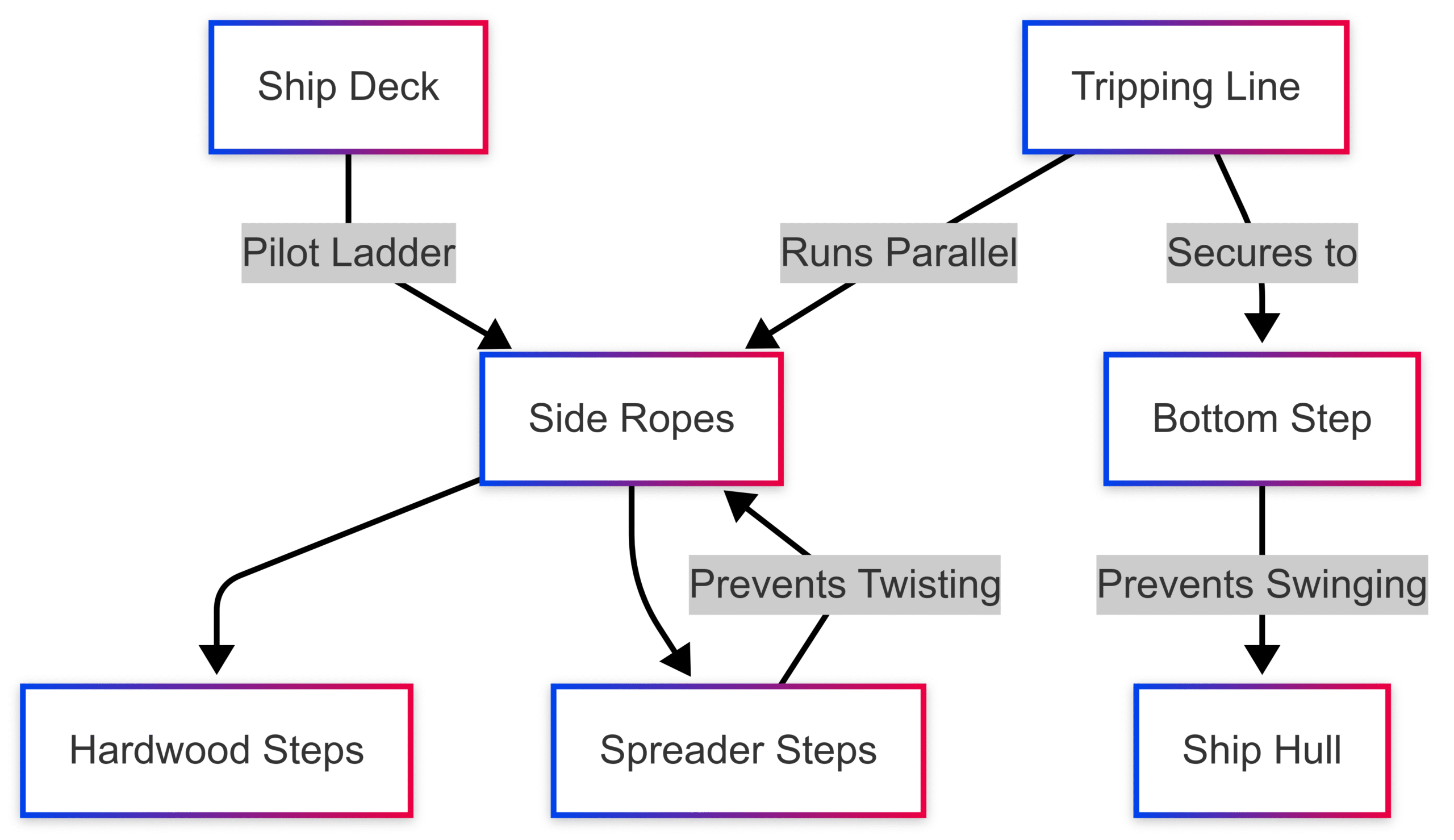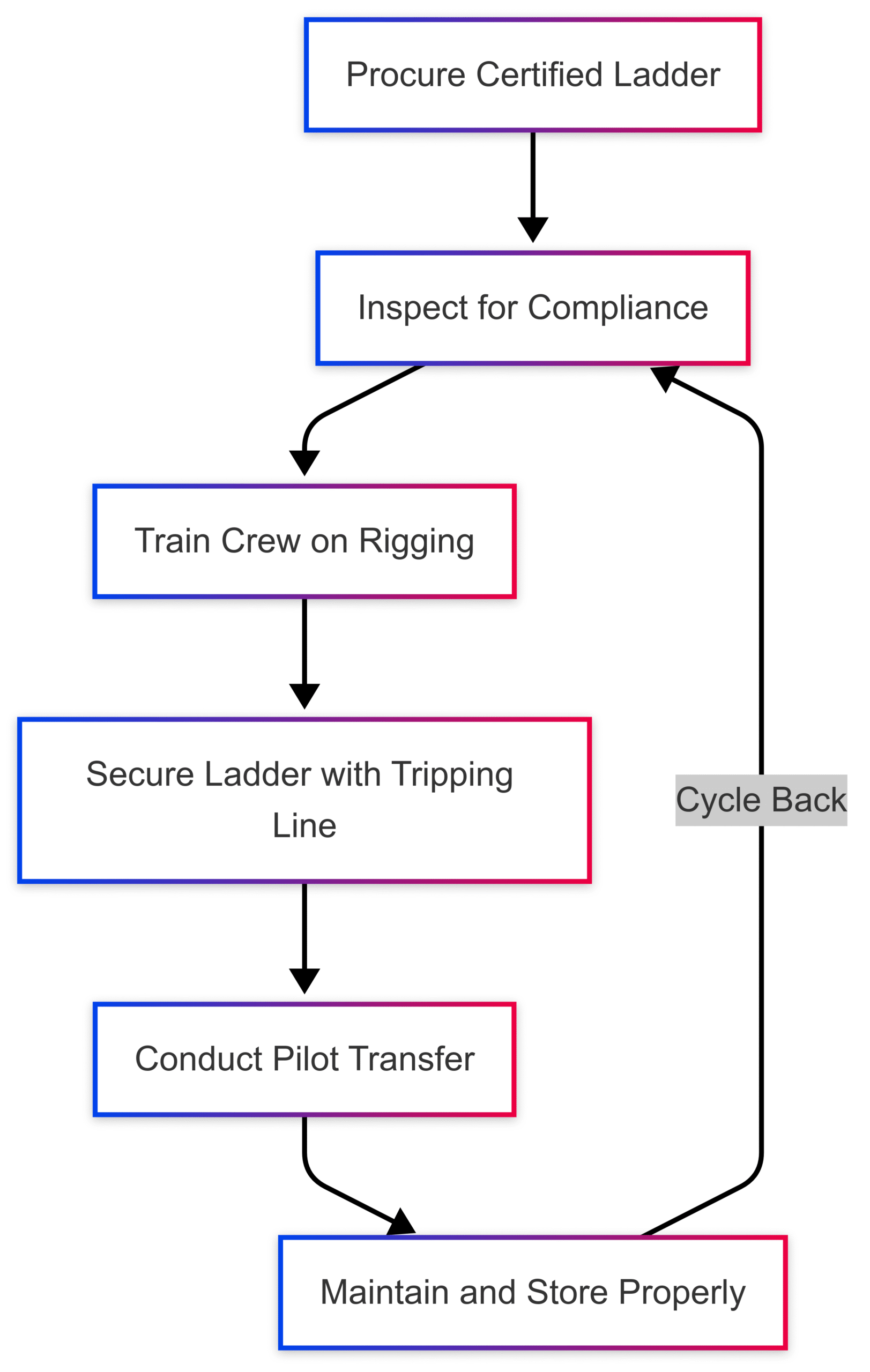The Crucial Element That Could Save Lives on Pilot Ladders
Discover the critical role of tripping lines in pilot ladder safety. Learn how they prevent accidents and ensure maritime safety.
Navigating the vast and unpredictable seas is a high-stakes endeavor where the safety of maritime personnel is paramount. Among the many tools and protocols designed to protect seafarers, one often-overlooked component stands out for its simplicity and life-saving potential: the tripping line on a pilot ladder. This unassuming rope, running parallel to the ladder, is a critical safeguard that prevents catastrophic accidents during the perilous act of boarding or disembarking a vessel. In this comprehensive exploration, we delve into the tripping line’s function, its compliance with international standards, the importance of training, and the future of pilot ladder safety, highlighting why this modest feature is a game-changer in maritime operations.
Understanding the Pilot Ladder and Its Challenges
Pilot ladders are specialized rope ladders used by maritime pilots, seafarers, and inspectors to board and disembark ships at sea. These ladders, typically made of hardwood steps and strong side ropes, are rigged from a fixed point on the ship’s deck to hang over the side, allowing personnel to climb to or from a smaller pilot boat. The process is inherently risky, with pilots often scaling heights of up to nine meters or more, sometimes in rough seas, strong winds, or low visibility. A fall from such heights can be deadly, with impact speeds approaching 50 km/h, whether striking the water or the pilot boat below.
The primary danger lies in the ladder’s instability if not properly secured. Without adequate measures, the ladder’s bottom step can swing away from the ship’s hull, a phenomenon known as “ladder hooking.” This leaves the ladder suspended in mid-air, creating an unstable and hazardous climbing surface. Such incidents have led to severe injuries and fatalities, underscoring the need for robust safety mechanisms.
What is a Tripping Line?
The tripping line, sometimes referred to as the ladder pilot rope, is a simple yet ingenious component attached to the pilot ladder. It runs parallel to the ladder’s side ropes, extending from the top to the bottom, and is designed to be easily accessible to the pilot or crew. Typically made of durable, non-slip material like manila rope, the tripping line is securely fastened to ensure it remains taut and functional under various sea conditions.
The tripping line’s primary purpose is to stabilize the ladder by keeping its lower end flush against the ship’s hull. By pulling or adjusting the line, the pilot or crew can prevent the ladder from swinging outward, mitigating the risk of ladder hooking. This seemingly minor feature acts as a lifeline, providing stability and confidence to those navigating the ladder.

The Life-Saving Function of the Tripping Line
The tripping line’s most critical role is preventing ladder hooking, a dangerous situation where the ladder’s bottom step swings away from the ship, leaving the climber suspended precariously. This can occur due to improper rigging, insufficient securing, or external forces like waves or the pilot boat’s movement. The consequences are dire: a pilot or seafarer could lose their grip, fall, and suffer severe injuries or death.
By pulling the tripping line, the pilot can ensure the ladder remains in contact with the ship’s hull, maintaining a stable climbing surface. This action distributes the ladder’s weight evenly across the side ropes, which are designed to handle significant loads (with a minimum breaking strength of 24 kN per rope, or 96 kN combined for four ropes). The tripping line thus acts as a dynamic safety tool, allowing real-time adjustments during boarding or disembarking.
Real-world incidents highlight the tripping line’s importance. For example, in one case, a pilot fell five meters into icy waters when a side rope parted due to improper securing, a situation that could have been mitigated with a properly used tripping line. The tripping line’s ability to maintain ladder stability is not just a convenience but a critical defense against such accidents.
Compliance with International Safety Standards
The importance of the tripping line is recognized by global maritime authorities, particularly the International Maritime Organization (IMO). Under SOLAS (Safety of Life at Sea) Regulation V/23, pilot ladders must be equipped with a tripping line that is easily identifiable, securely attached, and extends the full length of the ladder. This regulation ensures that the tripping line is a standard feature, not an optional add-on.
The IMO’s standards are complemented by the International Organization for Standardization (ISO), particularly ISO 799-1:2019, which provides detailed specifications for pilot ladder design and construction. Key requirements include:
- Side Ropes: Must be mildew-resistant manila or equivalent material, with a diameter of 20–22 mm and a minimum breaking strength of 24 kN. The ropes must be continuous, with no joints, and protected against UV degradation.
- Steps: Hardwood steps must be knot-free, straight-grained, and unpainted to ensure a non-slip surface. The four lowest steps must be made of durable rubber or equivalent material.
- Spreader Steps: Positioned at least every fifth step, these are at least 1.8 meters long to prevent ladder twisting.
- Markings: Permanent markings every three steps (approximately 1 meter) facilitate accurate rigging, and the ladder must bear the manufacturer’s name, serial number, date of manufacture, and approving authority details.
These standards ensure that pilot ladders, including their tripping lines, are robust, reliable, and capable of withstanding the harsh marine environment. Non-compliance, such as using substandard materials or improper rigging, contributes to over 16% of pilot ladder-related deficiencies reported by organizations like RightShip.
| Component | Specification | Purpose |
|---|---|---|
| Side Ropes | 20–22 mm diameter, 24 kN breaking strength, mildew-resistant manila | Bear ladder and climber weight, ensure durability |
| Steps | Hardwood, knot-free, 400 mm long, 115 mm wide, 25 mm deep | Provide stable, non-slip climbing surface |
| Spreader Steps | Minimum 1.8 m long, every 5th step | Prevent ladder twisting |
| Tripping Line | Runs full length, securely attached | Prevents ladder hooking, ensures stability |
| Markings | Every 3 steps (~1 m), manufacturer details | Facilitate rigging, ensure traceability |
The Role of Training and Awareness
While the tripping line is a vital safety feature, its effectiveness depends on proper use. Maritime professionals must be trained not only in rigging and inspecting pilot ladders but also in understanding the tripping line’s purpose and operation. Inadequate training contributes to incidents, as evidenced by cases where crew members failed to secure ladders properly or used unsafe rigging methods.
Training programs should cover:
- Inspection: Checking for worn steps, frayed ropes, or improper markings.
- Rigging: Securing the ladder to a designated strong point on the deck, not railings, and ensuring the tripping line is taut.
- Operation: Teaching pilots and crew how to use the tripping line to maintain ladder stability during transfers.
- Maintenance: Proper stowage in dry, shaded areas to prevent UV damage and rot.
The International Maritime Pilots’ Association (IMPA) emphasizes mandatory training as part of its annual safety campaigns, noting that non-compliance rates remain above 16%. By fostering a culture of awareness and adherence to standards, shipping companies can reduce accidents and enhance safety.
The nC2 Project: Scientific Evidence for Safer Ladders
The tripping line’s importance is further underscored by research conducted by nC2, a consultancy working with IMPA to improve pilot ladder safety. The project focused on resolving a debate about the safest method to secure pilot ladders at intermediate lengths—using traditional knots or metal D-shackles.
nC2’s Testing Methodology
nC2 conducted three work packages to evaluate ladder performance:
- Tensile Testing: Measured the strength of ladder components, including plain ropes, knotted ropes, and steps, to establish baseline characteristics.
- Slip and Grip Testing: Assessed how different knots and strops gripped the ladder’s side ropes under load, simulating wear.
- Cyclic Tension Testing: Simulated two years of in-service wear by applying 1,500 cycles of load to ladders secured with D-shackles, testing for failure points.
The results revealed that knots, when properly tied, distribute weight across the stronger side ropes, reducing stress on individual steps. D-shackles, while easier to use, can concentrate force on steps, potentially causing localized damage. These findings are driving proposed amendments to SOLAS Regulation V/23, expected to take effect by 2028, emphasizing evidence-based safety improvements.
Real-World Incidents and Lessons Learned
Pilot ladder accidents are not uncommon, with tragic consequences. The following cases illustrate the risks and the role of the tripping line:
- Case 1: A pilot fell when a side rope parted due to improper securing. A tripping line could have stabilized the ladder, preventing the swing that caused the fall.
- Case 2: A retrieval line caught on a pilot boat’s cleat, pulling the ladder away. A properly rigged tripping line could have kept the ladder secure against the hull.
- Case 3: A crew member fell from an unsecured accommodation ladder platform, highlighting the need for proper rigging and PPE use, which complements the tripping line’s role.
- Case 4: A surveyor fell from a slack pilot ladder, exacerbated by refusing a safety harness. A tripping line could have maintained ladder tension.
These incidents highlight root causes like inadequate training, substandard equipment, and failure to follow procedures. The tripping line, when used correctly, addresses many of these issues by ensuring ladder stability.
The Future of Pilot Ladder Safety
As the maritime industry evolves, so must its safety measures. Innovations like smart sensors to monitor ladder tension or advanced rigging systems could enhance the tripping line’s effectiveness. For example, sensors could alert crews to improper ladder alignment, while automated rigging systems could ensure consistent securing methods.
IMPA’s ongoing safety campaigns advocate for treating pilot ladders as safety-critical consumables with a finite lifespan, typically two years. This approach, combined with mandatory training and third-party certification, aligns with proposed SOLAS amendments to eliminate non-compliant equipment and practices.

Conclusion
In the high-stakes world of maritime operations, the tripping line on a pilot ladder is a small but mighty tool that prevents life-threatening accidents. By stabilizing the ladder and preventing hooking, it safeguards pilots, seafarers, and inspectors who risk their lives navigating the seas. Compliance with IMO and ISO standards, rigorous training, and evidence-based improvements like those from the nC2 project are critical to maximizing its effectiveness. As the industry looks to the future, embracing technological advancements and a culture of safety will ensure that the tripping line remains a cornerstone of maritime safety, protecting those who keep global trade afloat.
Specifications and Pricing
Pilot ladders are manufactured by reputable suppliers like PTR Holland and Mariteam, adhering to SOLAS and ISO 799-1:2019 standards. Typical specifications include:
- Material: Manila side ropes, hardwood or rubber steps.
- Length: Customizable, typically 6–15 meters, depending on ship freeboard.
- Price: $500–$2,000, depending on length and materials. Certified ladders from reputable manufacturers cost more but ensure compliance.
For pricing details, visit manufacturers’ websites or contact suppliers directly, as costs vary based on customization and certification requirements.
By prioritizing the tripping line and adhering to best practices, the maritime industry can significantly reduce risks and save lives, ensuring safer seas for all.
Happy Boating!
Share The Crucial Element That Could Save Lives on Pilot Ladders with your friends and leave a comment below with your thoughts.
Read Reducing the Risk of Collision in Areas of Heavy Boat Traffic until we meet in the next article.






